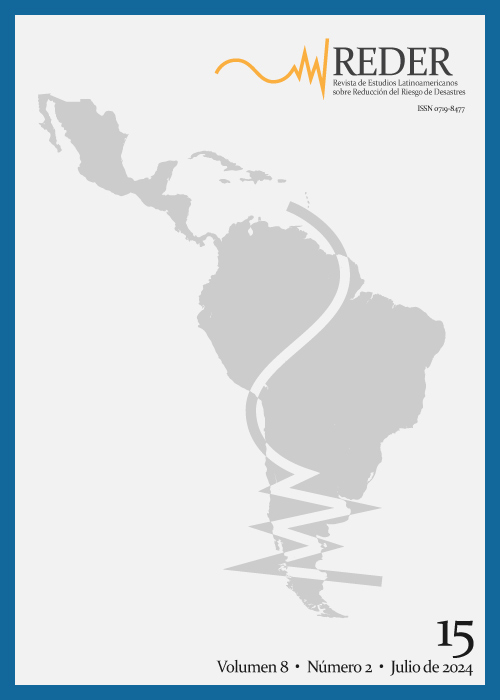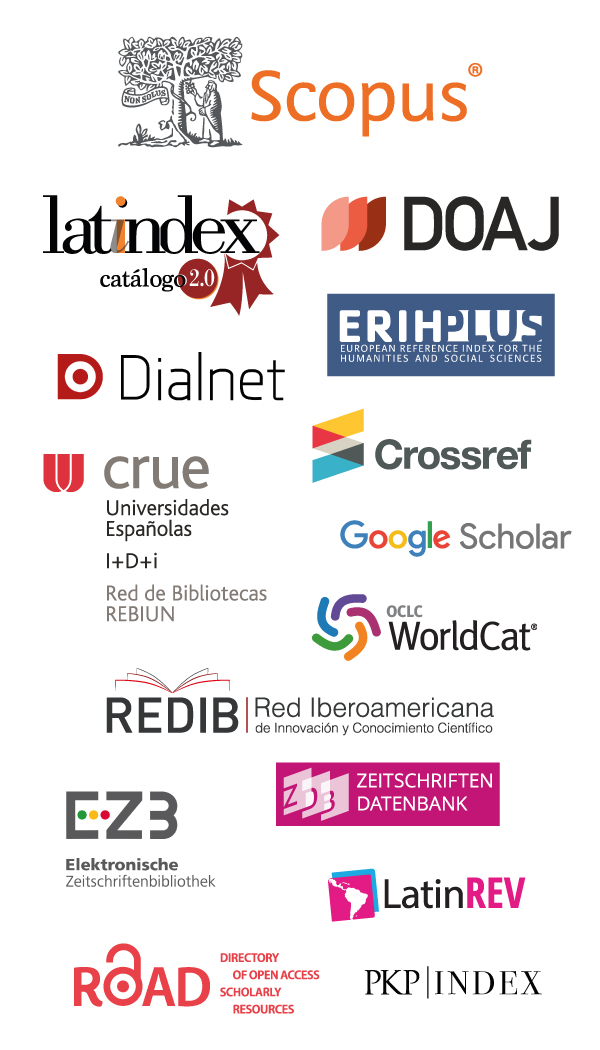Resiliencia Impugnada: Los efectos del terremoto de Manabí-Ecuador en la predisposición a participar en espacios de cooperación
DOI: https://doi.org/10.55467/reder.v5i2.75
Resumen
¿Cuál es el impacto que provocan los desastres sobre la participación en espacios de cooperación? ¿Qué implicaciones tienen estos efectos sobre el entendimiento de la vulnerabilidad social? Al comparar la predisposición a participar en espacios de cooperación antes y después de un terremoto se puede identificar cuán intensa es la hipotética existencia de resiliencia automatizada, entendida como la capacidad que tiene una comunidad para superar circunstancias traumáticas.Manabí, la provincia más poblada del Ecuador, soportó en abril del 2016 un terremoto de 7,8MW, donde fallecieron más de 600 personas. Utilizando la técnica cuasi-experimental de Diferencias en Diferencias (DiD) se estima el efecto del terremoto en las predisposiciones a formar parte de cooperativas en las poblaciones afectadas por el desastre y luego se las compara con las poblaciones no afectadas. Los resultados permiten concluir que el terremoto no incrementósignificativamente esta predisposición; no obstante argumentamos sobre la existencia de factores sociales, económicos y demográficos asociados a la variación. Estos hallazgos permiten proponer que la capacidad de reacción no es automática y depende de factores subyacentes y estructurales. A su vez, los hallazgos permiten contribuir a la interpretación de la conceptualización de la vulnerabilidad social alejándose de nociones individualistas y economicistas.
Palabras clave
Texto completo:
PDFReferencias
Abadie, A. (2005). Semiparametric Difference-in-Differences Estimators. The Review of Economic Studies, 72(1),1–19.
Alexander, D. (2013). Resilience and disaster risk reduction: an etymological journey. Natural Hazards and Earth System Sciences, 13(11), 2707–2716. http://doi.org/10.5194/nhess-13-2707-2013
Angrist, J.D., & Krueger, A.B. (1999). Empirical Strategies in Labor Economics. In Handbook of Labor Economics (pp.1277–1366) Vol. 3. Elsevier.
Angrist, J.D., & Pischke, J.S. (2009). Mostly Harmless Econometrics: An Empiricist’s Companion. Princeton University Press.
Ayyub, Bilal. (2015). Practical Resilience Metrics for Planning, Design, and Decision Making. ASCE-ASME Journal of Risk and Uncertainty in Engineering Systems, Part A: Civil Engineering, 1, 04015008. http://doi.org/10.1061/AJRUA6.0000826
Bertrand, M., Duflo, A., & Mullainathan, S. (2002). How Much Should We Trust Differences-in-Differences Estimates?. National Bureau of Economic Research.
Bottrell, D. (2013). Responsibilised Resilience? Reworking Neoliberal Social Policy Texts. M/C Journal, 16. http://doi.org/10.5204/mcj.708
Bourdieu, P. (2010). La Producción de La Creencia. Contribución a Una Economía de Los Bienes Simbólicos. En El Sentido Social Del Gusto (pp.153–229). Siglo 21.
Briguglio, L., Cordina, G., Farrugia, N. & Vella, S. (2009). Economic Vulnerability and Resilience: Concepts and Measurements. Oxford Development Studies, 37(3), 229–47. http://doi.org/10.1080/13600810903089893
Bruneau, M., Chang, S., Eguchi, R., Lee, G., O’Rourke, T., Reinhorn, A., Shinozuka, M., Tierney, K., Wallace, W. & Winterfeldt, D. (2003). A Framework to Quantitatively Assess and Enhance the Seismic Resilience of Communities. Earthquake Spectra - EARTHQ SPECTRA, 19. http://doi.org/10.1193/1.1623497
Burton, I., Huq, S., Lim, B., Pilifosova, O. & Schipper, E.L. (2002). From Impacts Assessment to Adaptation Priorities: The Shaping of Adaptation Policy. Climate Policy, 2(2–3),145–59. https://doi.org/10.3763/cpol.2002.0217
Busso, G. (2001). Vulnerabilidad Social: Nociones e Implicaciones Políticas Para Latinoamérica a Inicios Del Siglo XXI. CELADE-CEPAL.
Cretney, R. (2014). Resilience for Whom? Emerging Critical Geographies of Socio-Ecological Resilience. Geography Compass, 8(9), 627–40. http://doi.org/10.1111/gec3.12154
Dahlberg, R. (2015). Resilience and Complexity: Conjoining the Discourses of Two Contested Concepts. Culture Unbound: Journal of Current Cultural Research, 7(3), 541–57. http://doi.org/10.3384/cu.2000.1525.1572541
Dow, K. (1992). Exploring Differences in Our Common Future(s): The Meaning of Vulnerability to Global Environmental Change. Geoforum, 23(3), 417–36. http://doi.org/10.1016/0016-7185(92)90052-6
Eriksson, C., Kimber, B. & Skoog, T. (2018). Design and implementation of RESCUR in Sweden for promoting resilience in children: a study protocol. BMC Public Health, 18, 1250. https://doi.org/10.1186/s12889-018-6145-7
Gaillard, J. (2010). Vulnerability, capacity and resilience: Perspectives for climate and development policy. J. Int. Dev., 22, 218-232. https://doi.org/10.1002/jid.1675
Garmezy, N., Masten, A., & Tellegen, A. (1984). The Study of Stress and Competence in Children: A Building Block for Developmental Psychopathology. Child Development, 55(1), 97-111. https://doi.org/10.2307/1129837
Glewwe, P., & Muralidharan, K. (2016). Improving Education Outcomes in Developing Countries. In Handbook of the Economics of Education (pp.653–743) Vol. 5. Elsevier.
Haisch, T. (2017). Interplay between ecological and economic resilience and sustainability and the role of institutions: evidence from two resource-based communities in the Swiss Alps. Resilience, 6(3). 1–15. http://doi.org/10.1080/21693293.2017.1417679
Harris, L. Eric K. Chu & Ziervogel, G. (2018). Negotiated resilience. Resilience, 6(3). 196–214. http://doi.org/10.1080/21693293.2017.1353196
Harvey, D. (2014). Diecisiete Contradicciones y El Fin del Capitalismo. IAEN Quito.
Henry, D. & Ramirez-Marquez, J. (2012). Generic Metrics and Quantitative Approaches for System Resilience as a Function of Time. Reliability Engineering & System Safety, 99, 114–122. http://doi.org/10.1016/j.ress.2011.09.002
Holling, C.S. (1973). Resilience and Stability of Ecological Systems. Annual Review of Ecology and Systematics, 4(1), 1–23. https://doi.org/10.1146/annurev.es.04.110173.000245
INEC. (2016). Encuesta Nacional de Empleo, Desempleo y Subempleo - ENEMDU - Manual Metodológico. INEC.
Instituto Geofísico - EPN. (2018). Dos años después del Terremoto de Pedernales: actualización sísmica - Instituto Geofísico - EPN. Recuperado de: https://www.igepn.edu.ec/interactuamos-con-usted/1572-dos-anos-despues-del-terremoto-de-pedernales-actualizacion-sismica
Joseph, J. (2013). Resilience as embedded neoliberalism: a governmentality approach. Resilience, 1(1), 38–52. http://doi.org/10.1080/21693293.2013.765741
Kaztman, R., Beccaria, L., Filgueira, F., Golbert, L., Kessler, G., ILO Multidisciplinary Technical Advisory Team, & Ford Foundation. (1999). Vulnerabilidad, activos y exclusión social en Argentina y Uruguay. Equipo Técnico Multidisciplinario para Argentina, Brasil, Chile, Paraguay y Uruguay.
King, H., Crossley, S., & Smith, R. (2021). Responsibility, resilience and symbolic power. The Sociological Review. https://doi.org/10.1177/0038026120986108
Larrabure, M., Vieta, M. & Schugurensky, D. (2011). The ‘New Cooperativism’ in Latin America: Worker- Recuperated Enterprises and Socialist Production Units. Studies in the Education of Adults, 43(2), 181–196. http://doi.org/10.1080/02660830.2011.11661612
Lee, K.N. (1999). Appraising adaptive management. Conservation Ecology, 3(2), 3. https://doi.org/10.5751/ES-00131-030203
Lentzos, F., & Rose, N.S. (2017). Making us resilient: Responsible citizens for uncertain times. In S. Trnka, & C. Trundle (Eds.), Competing Responsibilities: The Ethics and Politics of Contemporary Life. Duke University Press.
Martínez, J.A.F. (2016). La Trampa Neoliberal de La Resiliencia. Papeles de Relaciones Ecosociales y Cambio Global, (134), 129–38.
Meerow, S., Newell, J.P., & Stults, M. (2016). Defining Urban Resilience: A Review. Landscape and Urban Planning, 147, 38–49. http://doi.org/10.1016/j.landurbplan.2015.11.011
Mogrovejo, R., Mora, A. & Vanhuynegem, P. (2012). El cooperativismo en América Latina. Una diversidad de contribuciones al desarrollo sostenible. Oficina de la OIT para los Países Andinos.
Oxford Development Studies. (2009). Vulnerability in Development. Advances in Concept and Measurement, 37(3).
Pelling, M. & Dill, K. (2010). Disaster Politics: Tipping Points for Change in the Adaptation of Sociopolitical Regimes. Progress in Human Geography, 34(1), 21–37. http://doi.org/10.1177/0309132509105004
Pizarro, R. (2001). La vulnerabilidad social y sus desafíos: una mirada desde América Latina. CEPAL - División de Estadística y Proyecciones Económicas.
Ranci, C. (2010). Social Vulnerability in Europe: The New Configuration of Social Risks. Palgrave Macmillan.
Ratner, C. (2009). Cooperativism: A Social, Economic, and Political Alternative to Capitalism. Capitalism Nature Socialism, 20, 44–73.
Reed, D., Kapur, K. & Christie, R. (2009). Methodology for assessing the resilience of networked infrastructure. IEEE Systems Journal, 3(2), 174–180. http://doi.org/10.1109/JSYST.2009.2017396
Rodríguez, C.A.R., Labrador Machín, O. & Alemán, J.L.A. (2006). El Cooperativismo. Revista Idelcoop, 33(168).
Rodríguez Vignoli, J. (2001). Vulnerabilidad y grupos vulnerables: un marco de referencia conceptual mirando a los jóvenes. Naciones Unidas, CEPAL, Proyecto Regional de Población CELADE-FNUAP, Centro Latinoamericano & Caribeño de Demografía (CELADE), Div. de Población.
Schmidtlein, M.C., Deutsch, R.C., Piegorsch, W.W. & Cutter, S.L. (2008). A Sensitivity Analysis of the Social Vulnerability Index. Risk Analysis, 28(4), 1099–1114. http://doi.org/10.1111/j.1539-6924.2008.01072.x
SEPS. (2020). Actualidad y Cifras Economia Popular y Solidaria. SEPS.
Siapera, E. & Papadopoulou, L. (2016). Entrepreneurialism or Cooperativism?. Journalism Practice, 10(2), 178–195. http://doi.org/10.1080/17512786.2015.1125760
Tate, E. (2013). Uncertainty Analysis for a Social Vulnerability Index. Annals of the Association of American Geographers, 103(3), 526–43. http://doi.org/10.1080/00045608.2012.700616
Tierney, K. (2014). The Social Roots of Risk: Producing Disasters, Promoting Resilience. Stanford University Press.
Tobin, G. (1999). Sustainability and community resilience: the holy grail of hazards planning?. Global Environmental Change Part B: Environmental Hazards, 1(1), 13–25. https://doi.org/10.3763/ehaz.1999.0103
Trell, E-M., Restemeyer, B., Bakema, M. & van Hoven, B. (2018). Governing for resilience in vulnerable places - an introduction. Routledge. https://doi.org/10.4324/9781315103761
Uekusa, Shinya. (2018). Rethinking resilience: Bourdieu’s contribution to disaster research. Resilience, 6(3), 181–195. http://doi.org/10.1080/21693293.2017.1308635
Ungar, M. & Liebenberg, L. (2011). Assessing Resilience Across Cultures Using Mixed Methods: Construction of the Child and Youth Resilience Measure. Journal of Mixed Methods Research, 5(2), 126-149. http://doi.org/10.1177/1558689811400607
United Nations and Development Programme - UNDP. (2011). Towards Human Resilience: Sustaining MDG Progress in an Age of Economic Uncertainty. United Nations Publications.
UNPD. (2016). Putting People First: Practice, Challenges and Innovation in Characterizing and Mapping Social Groups. UNDP.
Welle, T. & Birkmann, J. (2015). The World Risk Index. JoEE, 2(1), 1550003. http://doi.org/10.1142/ S2345737615500037
Welsh, M. (2014). Resilience and responsibility: Governing uncertainty in a complex world. The Geographical Journal, 180(1), 15–26. http://doi.org/10.1111/geoj.12012
Wilson, G. & Wilson, O. (2019) Assessing the resilience of human systems: a critical evaluation of universal and contextual resilience variables. Resilience, 7(2), 126–148. http://doi.org/10.1080/216932 93.2018.1539205
Wisner, B., Blaikie, P., Cannon, T., & Davis, I. (2004). At Risk: Natural Hazards, People’s Vulnerability, and Disasters (2nd ed). Routledge.
Yates, T.M., & Masten, A.S. (2004). Fostering the Future: Resilience Theory and the Practice of Positive Psychology. In Positive psychology in practice (pp.521–39). John Wiley & Sons Inc.
Enlaces refback
- No hay ningún enlace refback.








